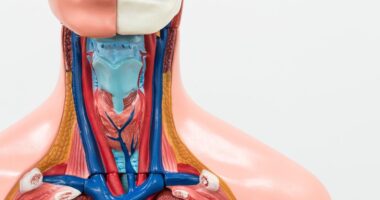Lack of Experience May Raise Post-surgery Hypoparathyroidism Risk
Removal of lymph nodes also identifed as risk factor in parathyroid gland damage

Less experienced surgeons and removing lymph nodes in the neck during thyroid surgery are the main risk factors of accidentally damaging the neighboring parathyroid glands, which can cause hypoparathyroidism, a large study in China showed.
A surgeon’s inexperience and a more advanced thyroid tumor also increased the risk of unintentional parathyroid gland damage.
These findings add to an increasing number of studies underscoring a link between the number of thyroid surgeries a surgeon performs every year and rates of post-surgery complications.
The study, “The analysis of risk factors for accidental parathyroid resection during thyroid surgery: a retrospective analysis of 1775 patients,” was published in Surgery Today.
Thyroidectomy, a surgery to remove all or part of the thyroid gland in the neck is often recommended for thyroid tumors, which can be either benign (noncancerous) or malignant (cancerous).
This type of surgery can lead to complications, including the unintentional damage or removal of the neighboring parathyroid glands, which produce the parathyroid hormone (PTH) that regulates calcium and phosphate levels in the blood.
Parathyroid glands’ damage or removal can either temporarily or permanently limit PTH production, a condition called hypoparathyroidism. Given that effective PTH replacement therapy has yet to be developed, it’s “important to identify and protect the parathyroid gland effectively during operations,” the researchers wrote.
Parathyroid removal’s link to hypoparathyroidism
Researchers in China investigated the effects of accidental parathyroid removal, or APR, on hypoparathyroidism and its potential risk factors. APR was classified as the detection of parathyroid gland material on the surgically removed thyroid tissue upon analysis.
They retrospectively analyzed data from 1,775 patients (74.7% women; mean age, 44.73 years) who underwent thyroidectomy at Fujian Medical University Union Hospital, China from November 2018 to October 2020.
Most (78.1%) had thyroid papillary carcinoma, the most common type of thyroid cancer, while 21.9% had benign thyroid tumors. Lymph nodes in the center of the neck closest to the thyroid were removed in all cases since they’re often the first site of cancer spread. Lymph nodes from both the central and lateral neck region were removed in 15.7% of patients.
A total of 860 surgeries (46.4%) were performed by professional surgeons, or those who conduct more than 300 procedures each year, while the remaining 915 (51.6%) were by less experienced surgeons.
Accidental parathyroid removal occurred in 255 surgeries (14.4%) — a rate similar to that reported in previous studies, the researchers noted. A larger proportion of surgeries with APR were conducted by less experienced surgeons than by professional surgeons (62.4% vs. 37.6%).
The PTH and calcium levels before and at one day, one week, and six months after surgery were available for analysis only for those operated on by a professional surgeon. Data showed patients with APR had significantly lower PTH levels than the non-APR group at all times after surgery.
A significantly higher proportion of those with APR during surgery experienced hypoparathyroidism relative to those without APR at one day after surgery (80.2% vs. 39.1%), one week post-surgery (47.9% vs. 13.1%), and six months post-surgery (15.6% vs. 0%).
“This demonstrates that, in addition to [APR], mechanical traction, compression, and damage to the blood supply of parathyroid glands during the operation all lead to a transient decrease in PTH,” the researchers wrote.
When the glands don’t remain intact, normalization of PTH levels may take more than six months to occur or may never be achieved.
No significant group differences were found for calcium levels at one day and six months post-surgery, which “was mainly because patients in both groups were routinely given [preventive] calcium supplementation after surgery,” the researchers wrote.
Lymph node removal and a surgeon’s experience level were simultaneously identified as independent risk factors of accidental parathyroid gland removal by statistical models that considered multiple factors.
Specifically, removal of the lymph nodes during surgery was associated with a 3.23-times higher risk of APR and the procedure by a less experienced surgeon increased the risk twofold.
Among patients having surgery for thyroid papillary carcinoma, a surgeon’s lower experience level was associated with an 83.7% higher risk of APR and more advanced cancer increased the risk by 36.5%.
Professional surgeons did surgeries on more complex cases, but removed a higher number of lymph nodes and cancer-invaded lymph nodes, suggesting a more thorough procedure, analyses showed.
As such, “despite the greater complexity of patient cases,” APR was less likely with professional surgeons than those “who had less professional experience,” the researchers wrote.
These findings showcase that “the causes of accidental parathyroid resection are multifactorial,” the researchers wrote, adding “the predictors of APR include lymph node dissection in the central region, [cancer] stage, and the operating surgeons’ experience.”







